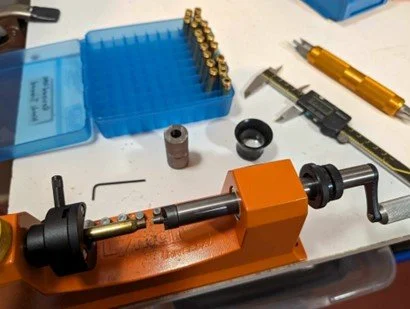When Your Job Becomes Your Hobby
For most, the concepts of work and hobbies are like oil and water—they don’t mix. One is a means to pay the bills, while hobbies offer an escape where we can explore our passions and find joy outside of the nine to five grind. But what happens when those lines blur, and the skills honed at the office translate surprisingly well to your hobby, and vise versa?
As a Vice President of Operational Excellence in a bustling manufacturing startup, my days are filled with streamlining processes, optimizing efficiency, and ensuring quality assurance and control. Yet, come nightfall, I find myself winding down by reloading ammunition for hunting and target shooting, fly tying, hunting or fishing. But when I stop and think about it, I’m doing a lot of the same things I do all day at work.
This unexpected overlap, far from being a disconnect, has become a testament to the flexible nature and value of professional skills, and the enriching power of utilizing those skills towards something you do just for the fun of it.
Precision and Process
The reloading bench has a lot in common with manufacturing work areas
At the heart of both my job and my reloading hobby lies a relentless pursuit of precision. In manufacturing, this translates to ensuring consistent product quality within tight tolerances. Every step of the manufacturing process, from raw material selection to final assembly, is meticulously monitored and adjusted to eliminate sources of variation. Similarly, reloading demands attention to detail. Each measured powder grain, the overall length of each reworked brass case, and bullet design greatly contributes to the precision and performance of the final product.
The concept of process management also plays a crucial role in both worlds. In manufacturing, we implement systems and procedures to ensure a process approach, efficient use of resources, and that our outputs are something the customer wants to pay for. Reloading follows a similar framework. I've developed a methodical approach with each step – from case cleaning to final inspection – so they are meticulously planned and executed. My reloading area might be the most organized room in my house, right down to a 5S label telling me where to find my Sharpie marker. This ensures consistency and minimizes the risk of errors, but also improves my efficiency, mirroring the production line mentality I utilize at work.
Problem-Solving
Manufacturing is an ever-evolving landscape. Unexpected challenges arise, requiring quick thinking and creative problem-solving skills. Whether it's a faulty machine component, a supplier issue, or a non-conforming process output, the ability to analyze the situation, identify root causes, and implement effective solutions is critical. The same problem-solving prowess comes into play with bow hunting for whitetail deer, especially when you’re not seeing them.
Y1: Why didn’t I see any deer tonight?
Answer: They didn’t walk past my stand location.
Y2: Why didn’t they walk past my stand location, there are deer tracks everywhere showing they regularly travel through this terrain feature?
Answer: I get game camera photos of them in this spot all the time after dark.
Y3: Why are they walking past my spot after dark?
Answer: They don’t have enough time to get to my stand location during hunting hours.
Y4: Why aren’t they getting to my hunting location during hunting hours?
Answer: It’s too far from their bedding area
Solution: I need to hunt closer to their bedding area.
Continuous Improvement: It Never Ends
One of the most significant aspects of Operational Excellence is the relentless pursuit of improvement. We constantly strive to optimize processes, identify areas for waste reduction, and implement solutions that not only improve a process, they add value to it. This same drive for continuous improvement fuels my fly tying endeavors. I’m always actively researching new materials and construction techniques, experimenting with different pattern color combinations, methodically making observations of natural insects and baitfish while recording catch data to track the performance of my fly patterns. This never-ending quest to get incrementally better mirrors the data-driven approach we take to improve efficiency within our team’s manufacturing operations.
The Unexpected Benefits
The unexpected overlap between my professional and personal life extends beyond practical skills. Both work and reloading provide a unique sense of accomplishment. Seeing good parts roll off the line or looking through the binoculars at touching bullet holes in a target from hand-loaded ammunition brings a deep sense of satisfaction. There's an inherent pride in mastering a complex process and utilizing your professional skills to create something of value away from work.
Furthermore, both pursuits offer a mental escape. Just as work allows me to focus on solving problems and optimizing systems, reloading provides a meditative outlet-- Ohmmmm. The repetitive, detail-oriented nature of the process allows me to unwind and focus on a singular task, temporarily shutting out the daily grind. Slow is smooth, smooth is fast, focus on the task at hand and decompress.
Which Leads Right Into My Last Metaphor: When Hobbies Enhance Your Day Job.
While the overlap between my work and hobby is undeniable, it's crucial to maintain a healthy balance. I make a conscious effort to ensure that my reloading activities remain a source of enjoyment, not an extension of my career. I avoid bringing work stress to the reloading or fly tying bench. This allows me to truly appreciate each activity for its distinct benefits.
You can use this same outlook to both minimize stress and get more fulfillment out of work. Cultivating emotional intelligence plays a vital role in managing work-related stress. By reframing challenges as opportunities for growth and maintaining a positive outlook, I’ve found that my stress levels have decreased dramatically, allowing me to enjoy my time at work at a level I never thought possible.




